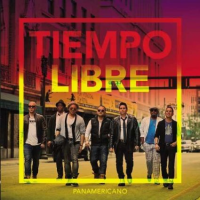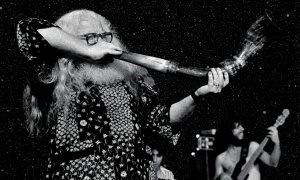Home » Jazz Articles » From the Inside Out » From Sea to Shining Sea: Music Central to South and Latin America
From Sea to Shining Sea: Music Central to South and Latin America
 Aguanko
Aguanko Invisible
Aguankó Music
2015
In 2012, conguero and composer Alberto Nacif, a Mexican native transplanted in Michigan, brought together some of the area's most skilled Afro-Cuban and Latin musicians to form Aguankó. Their small ensemble with a large Latin jazz sound herewith follows up their self-produced 2013 debut Elemental with a sparkling new set entirely written by Nacif, featuring Aguankó percussionist Jose "Pepe" Espinosa serving for the first time as their producer.
"The idea for the title and the concept for this new Aguankó recording is the invisibility of forces that guide us, move us, inspire us," Nacif reveals in his liner notes. "Love, friendship, respect, compassion, admiration, joy, longing..."
There is something undefinably and indescribably joyous about Nacif's music, the band's performance, and Espinosa's production, on Invisible. A sense of collective joy—the joy of creation, the joy of camaraderie and collaboration, and the simple joy of music—bubbles up from the chirping percussion and sunny brass of the opening "Sur La Seine" (mambo) like a refreshing mountain stream. The trombone solo by Christopher Smith flies so fleetly that you ears nearly hear it as a trumpet, but there's no mistaking the sound of Russell Miller's saxophone, which teams with the crackling piano solo to turn up the rhythmic flame. A subsequent 6/8 mambo "Luna Roja for Armando Peraza" is an absolute frenzy of brass, piano, and percussion from start to finish; I genuinely don't understand how someone could remain unmoved by this music.
On "Señor Belgrave," Nacif features two of Detroit's finest contemporary musicians, bassist Robert Hurst and trumpeter Marcus Belgrave. "Marcus Belgrave is a national treasure, and I am grateful for his gentle advice and longtime friendship. He is the dean of the Detroit school of good taste and style, and has been the master teacher to so many of us," the composer explains. "It is no surprise that he picked longtime collaborator and bassist Robert Hurst to record with us, and his bass intro to 'Señor Belgrave' is a one-take wonder, and a master class in itself."
The closing guaguankó "Un Futuro Brillante" ("A Bright Future") certainly sounds like it. Trumpeter Anthony Stanco combines the bright and blazing best of Latin jazz trumpet legends Dizzy Gillespie and Arturo Sandoval, while Nacif honors the sound and spirit of Afro-Cuban piano firebrand Arturo O'Farrill. Just like "Luna Roja," this absolute hurricane of melody and rhythm is such inspired, and inspiring, music.
Alberto Nacif is also a (General Practitioner) medical doctor, and the music he makes with Aguankó sounds healing, soulful, and life-affirming. Nominated for Ourstanding World Music release by the 2015 Detroit Music Awards, Invisible has thankfully raised Aguankó's visibility throughout the jazz community.
 Gabriel Alegría Afro-Peruvian Sextet
Gabriel Alegría Afro-Peruvian Sextet 10
ZOHO Music
2015
10 celebrates the ten-year anniversary of the Afro-Peruvian Sextet founded and simultaneously led by horn player Gabriel Alegria from New York City (where Alegría serves as Professor of Jazz Studies at New York University) and Lima, Peru. "It's a concept album," Alegría shares. "For our tenth anniversary, we wanted to give special care to American and Peruvian standards. It all comes together in the arrangements in the Afro-Peruvian style. We've incorporated many guest artists, people who have helped us along the way. Most importantly, we've brought together jazz musicians with eminent Peruvian musicians, and we're the glue that holds it together."
"New York is a place that's almost an orgy of people mixing things," Alegría continues. "You have to be careful to present things on their own terms. We work very hard to make sure each of the traditions is employed correctly, really knowing the background before we use it. That helped set the band apart and get attention."
10 is full of highlights from the American and Peruvian canons, but none shine more brightly than its first two tunes. The famous "Caravan" (by Juan Tizol and Duke Ellington) steps out on acoustic bass and percussion before erupting into its full-blown Afro-Cuban-Peruvian jam overflowing with sumptuous rhythms and brass; the palpable New Orleans jazz swagger in the solo horns that lead this piece lustily mixes with the Afro-Cuban frenzy of the vocal chants and shouts with which they're interspersed. "Take Five/El Condor Pasa" brilliantly arranges these two famous melodies (the second popularized by Simon & Garfunkel as "If I Could") to be played simultaneously by the rhythm and horn sections. Who would have thought these two tunes would find their common meeting ground in Latin jazz?
10 offers much, much more. Other classics from the jazz canon include "My Favorite Things" with bassist Ron Carter, an adventurous exploration through well-traveled musical ground; a version of "Birdland" in tribute to the great Peruvian percussionist (and former Weather Report member) Alex Acuña; and Ornette Coleman's famous "Lonely Woman" featuring a children's chorus, another inventive arrangement that challenges the listener's preconceptions of this tune and its composer.
Arturo O'Farrill graces "Himno Nacional del Perú" and "The Star Spangled Banner" with sensitive playing so beautiful and refined that these pieces genuinely feel like historic songs of state.
Alegría founded this Sextet while earning his doctorate at the University of Southern California; during these studies, he recorded and performed with Tierney Sutton, Bill Watrous, Russell Ferrante, and mentor Bobby Shew, all of whom appeared on the Sextet's debut, Nuevo Mundo (2008, Saponegro Records). "Afro-Peruvian jazz is a real thing, and we are going to continue to push it forward," Alegría promises. On the scale of one to ten, 10 advances Afro-Peruvian jazz with a perfect score.
 Chico Trujillo
Chico Trujillo Reina de Todas Las Fiestas
Barbés Records
2015
As the late 1990s transitioned into the early 2000s, in the small Chilean town called Villa Aleman, singer Aldo "Macha" Asenjo and other members of the local punk-ska group LaFloripondio would gather around and jam for fun on old classics from the Chilean and Columbian cumbia traditions. After fifteen years, six albums, and a few world tours together as Chico Trujillo, the band remains true to these roots: Their newest title, Reina de Todas Las Fiestas, translates as The Queen of All Parties.
Recorded across Argentina, Chile, Columbia, and Mexico, Las Fiestas captures a colorful, warm and celebratory sound—as if Chico Trujillo threw and recorded an outdoor party featuring cumbia, mariachi, marching and New Orleans brass bands, all randomly strolling in and out of the celebration. Several tunes, such as the bandeon-based "Se Nota En El Ambiente Que Tenemos Que Partir" and flute-fueled "Alturas," whip up the feeling of a twirling, traditional dance you might enjoy at an ethnic wedding celebration.
"Playas Marinas," a Columbian cumbia classic featuring singer Henrique Alvarez from Los Tres (one of Chile's most influential rock bands), incorporates the see-saw rhythmic tug of Caribbean music into its South American horns, guitars, bandeon and vocals. "Chatito," featuring Rebel Diaz, a hip-hop group from the Bronx fronted by two Chilean brothers, chirps up with a sunny 1960s Farfisa sound. The thin and trebly electric rhythm guitar of Peruvian chicha (traditional cumbia rewired in the 1960s with the guitar-heavy sound of psychedelic and surf rock) cuts through "Los Nervios Que Tedi," which also spotlights Argentinian pop star Kevin Johansen, and "La Cura Del Espanto."
But Las Fiestas saves its ultimate celebration for the closing, title track recorded with Banda Wiracocha, a 30-piece brass band from Northern Chile which specializes in pre-Hispanic songs, dances, and ritual and carnival music. This joint performance captures a wild and raucous celebration of their shared South American musical culture, and doesn't shut Las Fiestas down as much as it blows it up and out.
 Ithamara Koorax
Ithamara Koorax All Around the World
Jazz Vision Records
2014
All Around the World represents several milestones for firebrand Brazilian vocalist Ithamara Koorax: It marks her twentieth release as a leader, celebrates the 25th year of her career, and, just like her first official release (Ithamara Koorax Live in Rio [1993, JVC]), All Around the World comes digitally straight from the soundboard, with no overdubs or other studio corrections.
Just as importantly, All Around the World truly embodies the global state of modern jazz. Koorax's band features many contributors from Brazil, including keyboardist Mario Castro-Neves and legendary percussionist Dom Um Romao, and its program features such famous Brazilian composers as Antonio Carlos Jobim ("Agua de Beber") and Marcos Valle ("Black is Beautiful"). But her ensemble also includes musicians from Asia (Japanese bassist Mitsuru K. Natsuka) and Europe (English multi-instrumentalist Mark Peterson and German keyboardist Ursula Lauren), and their repertoire also includes songs by American composers ranging from Richard Rodgers to Herbie Hancock to Jimi Hendrix.
Koorax and company fly directly into "Brazilian Birds/My Favorite Things" with a galloping rhythm from which her voice carves out the words "bites" and "stings" with its sharp and strong edges. Then they jump into the deep end of "Agua de Beber" with an inventive hip-hop arrangement that slows its flow into a very dramatic and dark, nearly theatrical piece; Koorax shreds the second verse with an agonized shriek for life-giving water, and chokes out her closing vocalese as if her parched throat has begun to clench and close up from the unrelenting desert heat.
Koorax's voice luxuriates in the melody of "Butterfly" (written by Hancock and Bennie Maupin to showcase Maupin's soprano sax on The Headhunters' seminal Thrust [1974, Columbia]), arranged to allow all the sweetness and light of her voice to rise up and float, then echo and trail the bass line like a hopeful lover. "Black Is Beautiful" is another showcase for the show-stopping power of her voice, and you can easily hear Patti Labelle sing this song, in this way, in this arrangement.
Her traditional closer, "Mas Que Nada/A Carrocinha Pegou," bounces on hip-hop, Caribbean, and Brazilian rhythms shot through with turntable scratches and vocal loops. Koorax stretches out with animal-like growls and shrieks and cries and whistles, punching toe-to-toe with just drums and percussion in an incredible display of free-flying vocal improvisation.
Koorax has dedicated All Around the World to two keyboardists and two percussionists with whom she frequently performed and recorded, and have recently passed on: Percussionists Gaudencio Thiago de Mello and Jadir de Castro, and keyboard players Rodgers Grant and Jose Roberto Bertrami, who founded Brazilian fusion superpower Azymuth and who performed with the singer for more than two decades.
 Spanglish Fly
Spanglish Fly New York Boogaloo
Chaco World Music
2015
Even down to its very sound, "boogaloo" is a curious word that represents a curiously Latin American music, born during the 1960s immigration wave that spread from Puerto Rico into New York City and simultaneously growing like a friendly weed in and around the pop, soul, rock, and jazz musical cultures that were blooming throughout the city at that time.
Spanglish Fly brings together musicians from Canada, Cuba, Ecuador, Puerto Rico, Venezuela, and of course Manhattan, led by founder, brass player and native New Yorker Jonathan Goldman. "So many elements can be brought into boogaloo because the musical platform gives you plenty of room to do things. The spirit of the music is intensely inviting," Goldman explains. "I felt when I first got into the music that I was invited to a party. Boogaloo welcomes everyone, whatever degree of familiarity you have with Latin music and culture. It's a wide open door that says, 'Come on in here and dance with us. Have fun.'"
The fun never stops on New York Boogaloo. It opens just about perfectly with "Esta Tierra," a Spanish take on Woody Guthrie's iconic "This Land is Your Land" rendered in thick and tasty boogaloo, with funky bass, soulful organ, flame-throwing horns, a drumbeat so loose that it's tight, and Erica Ramos' sumptuous, sensuous lead vocal.
In "Love Graffiti Me," Ramos' lead and the harmonizing background vocals honor the 1960s girl-group hits (by The Shangri-Las, The Ronettes, The Shirelles, and so on) that blossomed from New York's famous downtown Brill Building. Its loping rhythm dances with classic '60s rock, too. Heading north to the Bronx, "42 (El Cuarenta y Dos)" pays tribute to retired New York Yankees relief pitcher and Panama native Mariano Rivera, the last major leaguer to wear Jackie Robinson's number 42. (Major League Baseball officially retired number 42 on April 15, 1997, the 50th anniversary of the game in which Robinson broke baseball's color barrier.) Lyrics such as "Smooth like butter/ All he needs is his cutter" prove that someone in this band knows their baseball lingo.
"Bump (and Let It Slide)" bumps and grinds with the eternal primal rhythm of a woman's hip-hugger jeans wriggling down the block, and its last verse embodies the Dionysian frenzy and release that characterizes some of the best music, in Latin or any other style: "Last night, I left my home up on the West Side/ This morning found me wake up on the East Side/ How this happened ain't so very clear/ But I'm glad tonight you and me are here/ To bump, and let it slide..."
The closing "Brooklyn Boogaloo" brings New York Boogaloo full circle. Recorded with boogaloo legend Harvey Averne, a kindred Jewish spirit in Manhattan's Latin music scene, it simultaneously delivers dance and musical history lessons. Ramos' triumphant shout out, "Just like we did back in the day/ Just put your hands together and say/ Beep beep, bang bang/ Brooklyn, do your thang..." honors Joe Cuba's seminal 1966 boogaloo hit "Bang Bang"; "Bang Bang" inspired Johnny Colon to compose his 1967 smash "Boogaloo Blues"; "Boogaloo Blues" lit such a fire under the fledgling Goldman that he spun records under the name "DJ Jonny Semi-Colon."
"Whatever boogaloo tune you listen to, you'll hear lots of really intense musicianship, but it all works together as something that sounds fun," Goldman concludes. "It doesn't make you shake your head and say, 'These guys are geniuses.' It makes you want to move your body."
 Tiempo Libre
Tiempo Libre Panamericano
Universal Music Latin Entertainment
2015
Panamericano is more than the title of the fifth release from Afro-Cuban maestros Tiempo Libre (which loosely translates into "Free Time"); after more than a decade of blending and polishing musical styles from Latin, South, and North America, it's a great description of the smooth sound they've found.
Each tune seems to literally dance off the music written by pianist and co-founder Jorge Gomez Abrante, who composed or co-composed every song. Recorded music doesn't sound much more bright or hot than this opening "Quién Soy Yo." Fueled by piano and percussion, the powerful rhythm section never overwhelms the music but finds the perfect balance between melody and rhythm; the production allows all the lead voices—instrumental and human—to shine, while the ensemble horns layer in another level of complexity and wonder. It must feel so wonderful and liberating to share your voice in an ensemble playing music as joyous as this.
"Callejero" works in hip-hop drums, jazz trumpet, and a husky rap shout out, plus an ensemble vocal chorus tightly screwed into its surrounding instrumentation; "Gallo Fino" churns out straight-line Columbian cumbia, with Descember Bueno gruffly ripping through his guest vocal spot. "Yo Estoy Aquí" features vocalist Frankie "Half Pint" Jaxon and saxophonist Sergio Chaple in a very glossy, commercial-sounding ballad that could have easily been lent from the Gloria Estefan / Miami Sound Machine songbook.
Just a little more loose and funky, "Somebody to Love Me" and the subsequent "Dime Que No" hit Panamericano's highpoints. In the former, percussion and piano perfectly dovetail into the intersection of rhythm and melody, while an electric guitar hook claws at the rhythm and Yunel Cruz's guest vocal somehow brings even more passion out of Tiempo Libre's torrid, tropical sound. "Dime Que No" erupts from that song's closing with barely a pause, with Jean Rodríguez's guest vocal cutting into and jumping out of its crackling instrumental cauldron; Gómez's piano ties the arrangement together with strong, sinewy lines while the horn ensemble threatens to blow it completely apart!
After releasing their first two sets on Sony Masterworks, Panamericano is Tiempo Libre's first release for Universal Music Latin Entertainment, celebrated by the band (and their fans) with performances in Spain, China, London and the New York Metropolitan Museum of Art.
 Various Artists
Various ArtistsPeru Boom: Bass, Bleeps & Bumps from Peru's Electronic Underground
Tiger's Milk Records
2015
Lima is often referred to as the intersecting point for the cross-pollinating Andean, African, European and South American cultures of Peru, the cradle of the Incas. Club revelers throughout Central and South America (and the DJs who the spin music that keeps them dancing) also consider Lima to be home base for the Tropical Bass sound and style, and the birthplace of "the digital cumbia boom" which fuels dancefloors from South Africa to South Central Los Angeles.
"It was a life-changing night three years ago that led to the beginning of Peru Boom," recalls Martin Morales, founder of Tiger's Milk Records. "I was invited by my friends in a band called Dengue Dengue Dengue to one of their parties. DJs were mixing chicha rhythms with serious basslines and halfway through the night, chicha bands from the 70s would play on stage. Kids would go nuts at both the tropical bass and the traditional sounds. This was like a modern rave Peruvian style like I'd never seen before. Peru Boom tries to capture that sound."
Working with Tiger's Milk co-founder Duncan Ballantyne and tropical bass DJ Chakruna (Jorge Espinoza, who taught himself guitar before he was ten years old and has been producing electronic and other music since 2001), Morales put together Peru Boom to showcase Peru's most vital underground DJs and producers. "We've attempted to give an overview of the last five years' development of the tropical bass scene in Peru," Chakruna explains. "Initially we intended to include a track for each bass producer but eventually realized that the album would benefit from solely focusing on a vibe. That vibe aims to show the variety of genres coming out of the scene, and the influence of Peruvian chicha and cumbia."
Chakruna pulls two such vibes from his own catalog: "Cumbia Achorada," a tone poem written in rivers and rockets of sound; and "Sonido Chichero (featuring Chapillita)," cumbia interwoven with percussion into a more detailed and deeper sound, behind celebratory verses which sound like the vocalist is toasting at a wedding party, drinking more wine and dropping more inhibitions with each passing line!
Upon Espinoza's special invitation, Peru Boom clears room for four selections from Tribilin Sound, the stage name of Peruvian producer Alvaro Ernesto. Most of these emphasize the sound of the Peruvian drum called the cajon, and these tunes connect the music, the musicians and the listeners the best: Cajon is the first sound you hear in "El Carmen," introducing other percussion that in turn introduces more somber, ethereal electronics. The more spacious mixes "Underground Cumbia" and "Negroide" move the cajon and chanting voices to center stage, connecting modern techno with the indigenous tribal.
"Eduardo Y Hank" closes this anthology not with a Boom but in a more meditative, ambient electronic sound, its dynamic percussion chirping and bubbling beneath gentle synthesizer washes borrowed from a classic Isley Brothers' 1970s soul ballad.
Tracks and Personnel:
Invisible
Tracks: Sur la Seine; Fashionably Late; Invisible; Babuka; Chico's Dream; Luna Roja (for Armando Peraza); Senor Belgrave; Madiba; Un Futuro Brillante.
Personnel: Alberto Nacif: congas; Jose "Pepe" Espinosa: timbales, guiro, bongos, batas; Carlos Mena: bass; Wesley Reynoso: piano; Russell Miller: saxophone, flute; Christopher Smith: trombone; Anthony Stanco: trumpet; Ric Roe: piano; Marcus Belgrave: trumpet; Robert Hurst: bass; Alberto Alberto Pino: vocals.
10
Tracks: Caravan; Take Five/El Condor Pasa; Taita Guaranguito; My Favorite Things; Birdland; Himno Nacional del Perú; Lonely Woman; Contigo Perú; Homenaje a Chincha; The Star Spangled Banner.
Personnel: Gabriel Alegría: trumpet, flugelhorn, guapeo, vocals; Laura Andrea Leguía: soprano sax, tenor sax, guapeo, vocals; Freddy "Huevito" Lobatón: cajón, quijada, cajita, campana, guapeo, vocals; Yuri Juárez: acoustic guitar, electric guitar, vocals; with Hugo Alcázar: drums, guapeo, vocals; Shirazette Tinnin: drums; Ron Carter: double bass; John Benitez: double bass; Essiet Essiet: double bass; Russell Ferrante: keyboards; Arturo O'Farrill: piano; Felix Valdelomar: guapeo, vocals; Octavio Castillo: steel guitar, kalimba; Daniel Susnjar: second drum set; Pepe Villalobos: guapeo, vocals; Rosita Guzmán: guapeo, vocals; Gustavo Urbina: guitar, vocals; Badal Roy: tablas, voice of the drum.
Reina de Todas Las Fiestas
Tracks: Abajo Del Bote; Malgeniosa; Playas Marinas; La Cura Del Espanto; Se Nota En El Ambiente Que Tenemos Que Partir; Alturas; Chatito; Los Nervios Que Tedi; Reina De Todas Las Fiestas.
Personnel: Juan Gronemeyer: drums, percussion; Michael Magliocchetti; guitar, vocals; Tuto Vargas: bajo; Sebastian Cabezas: trumpet; Tio Rodi: percussion; Luis Tabilo: trombone; Felita: saxophone; Macha Asenjo: guitar, vocals.
All Around the World
Tracks: Brazilian Birds/My Favorite Things; Agua de Beber (Water to Drink); Primavera; Butterfly; Human Nature; Black Is Beautiful; Cala Boca Menino; Brazilian Rhyme/What's Going On; Ela e Carioca (She's a Carioca); A Rã (The Frog); Up From the Skies; Mas Que Nada/A Carrocinha Pegou.
Personnel: Jay Berliner: guitar; José Roberto Bertrami: keyboards; Mario Castro-Neves: keyboards; Jadir de Castro: congas, percussion; Gaudencio Thiago De Mello: percussion; Eloir De Moares: congas, percussion; Arnaldo DeSouteiro: percussion, producer; Rodgers Grant: keyboards; Manuel Gusmão: bass; Mario Jansen: keyboards; Ithamara Koorax: vocals, percussion; Ursula Lauren: keyboards; Cesar Machado: drums; Hugh McCracken: guitar; Mitsuru K. Natsuka: bass; João Palma: drums, percussion; Mark Peterson: guitar, keyboards; Dom Um Romão: drums, percussion; Enio Santos: bass.
New York Boogaloo
Tracks: Esta Tierra; Bump (and Let It Slide); Return of the Po-Po; Martian Boogaloo; Mira Ven Aca; 42 (El Cuarenta y Dos); Love Graffiti Me; Me Gusta Mi Bicicleta; Cuidate Hermana; Brooklyn Boogaloo.
Personnel: Erica Ramos: lead vocal; Jonathan Goldman: trumpet, vocals; David Frankel, percussion, vocals; Charly Rodriguez: timbales, vocals; Mick Santurio: congas; Jonathan Flothow: baritone saxophone; Matt Thomas: tenor saxophone, vocals; Zach Seman: keyboards; Sebastian Isler: trombone; Rafael Gomez: bass; G. Thomasini: bongos; J. Bringas: bass; L. Curtis: bass.
Panamericano
Tracks: Quién Soy Yo; Callejero; Yo Estoy Aquí; Somebody to Love Me; Dime Que No; Rema; Monta Que Te Quedas; El Loco; Gallo Fino; Grandpa.
Personnel: Jorge Gomez: piano, musical director; Xavier Mili: lead vocals; Wilvi Rodriguez Guerra: bass; Luis Beltran Castillo: saxophone, flute; Leandro González: congas; Michel Ruiz Garcia: trumpet; Israel Morales Figueroa: drums; Luis Fernando Borjas: vocals; Armando Arce: drums; Yunel Cruz: vocals; Mr. Haka: rap; Descemer Bueno: vocals; Fabian Alvarez: flute; Armando Garcia: vocals; Jean Rodriguez: vocals; Michael Peraza: vocals, guitar.
Peru Boom: Bass, Bleeps & Bumps from Peru's Electronic Underground
Tracks: Luto (Animal Chuki); Ego Trip (Deltatron); Como Bailar Cumbia (Dengue Dengue Dengue); Naranja Limones (Piraña Sound System); Cumbia Achorada (Chakruna); Outropical (Version B) (Rolovo); El Carmen (Tribilin Sound); Iseecumbiapeopleagain (Qechuaboi); Subete a la Noche (Pe Garcia); Underground Cumbia (Tribilin Sound); El Que Abandona No Tiene Premio (Deltatron); Sonido Chichero (ft. Chapillita) (Chakruna); Tardes (Elegante & La Imperial); Negroide (Tribilin Sound); Marcha Del Chullachaqui (Deltatron Remix) (Los Chapillacs); Eduardo Y Hank (Tribilin Sound).
Personnel: Animal Chuki; Deltatron; Dengue Dengue Dengue; Piraña Sound System; Chakruna; Rolovo; Tribilin Sound; Qechuaboi; Elegante & La Imperial; Los Chapillacs.
< Previous
Let Me Love You
Comments
Tags
Aguanko
From the Inside Out
Chris M. Slawecki
Alberto Nacif
Christopher Smith
Marcus Belgrave
Anthony Stanco
Dizzy Gillespie
arturo sandoval
Gabriel Alegria
Juan Tizol
duke ellington
Ron Carter
Weather Report
Alex Acuna
Ornette Coleman
Tierney Sutton
Bill Watrous
Russell Ferrante
Bobby Shew
Ithamara Koorax
Dom Um Romao
Antonio Carlos Jobim
Marcos Valle
Mark Peterson
Richard Rodgers
Herbie Hancock
Jimi Hendrix
BENNIE MAUPIN
Patti LaBelle
Jose Roberto Bertrami
Azymuth
Spanglish Fly
Jonathan Goldman
The Shangri-Las
Joe Cuba
Tiempo Libre
Jorge Gómez
Frankie J
For the Love of Jazz
 All About Jazz has been a pillar of jazz since 1995, championing it as an art form and, more importantly, supporting the musicians who create it. Our enduring commitment has made "AAJ" one of the most culturally important websites of its kind, read by hundreds of thousands of fans, musicians and industry figures every month.
All About Jazz has been a pillar of jazz since 1995, championing it as an art form and, more importantly, supporting the musicians who create it. Our enduring commitment has made "AAJ" one of the most culturally important websites of its kind, read by hundreds of thousands of fans, musicians and industry figures every month.






















